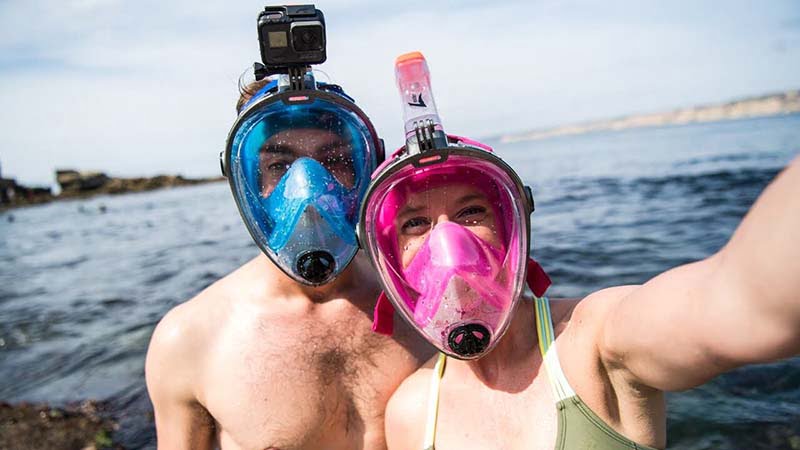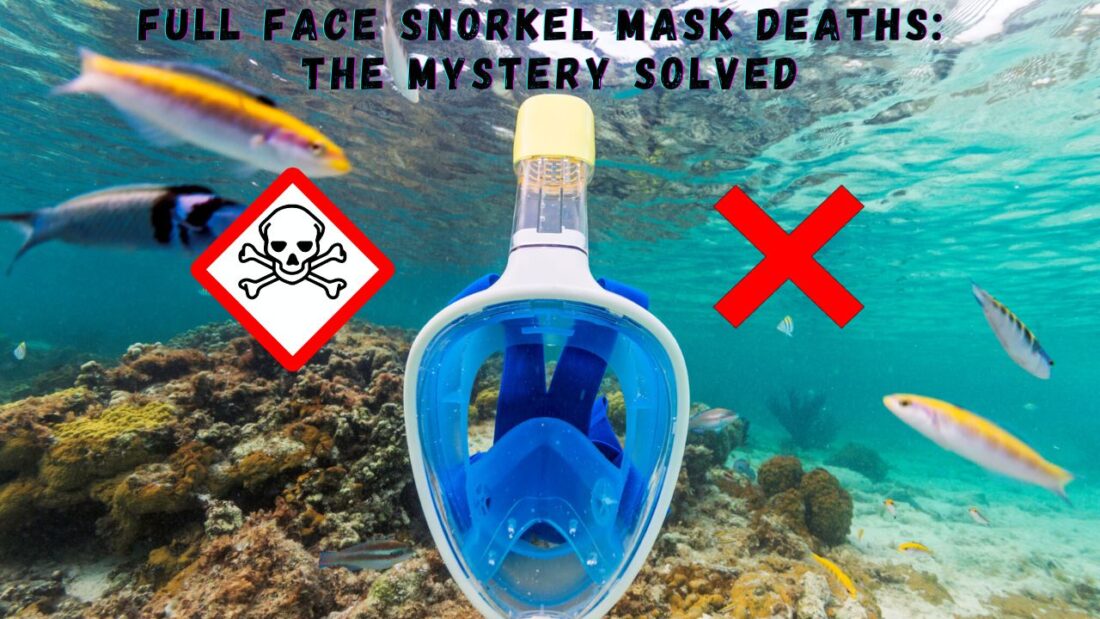Snorkeling is a delightful way to explore the underwater world, but it’s not without its dangers. In recent years, full-face snorkel masks have gained popularity. They have promised a more comfortable experience. However, beneath the surface there’s a murky truth: An alarming increase in snorkel-related deaths. Unfortunately these mis happenings have doubled in the past four years around the world. In most of the cases the allegation went to-Full Face Snorkel Masks. Are these masks the real culprit? Let’s get into details of- Alleged Full Face Snorkel Mask Deaths and explore the mystery behind it:
Why Full Face Masks Are So Popular

- Full face masks are convenient. The mask and snorkel are combined into one unit.
- Breathing is easier without needing to clear a separate snorkel. The large visors give wider views underwater.
- Many full face snorkel masks are equipped with mounted GoPro-style cameras or Bluetooth speaker to enhance the snorkeling experience with photos, videos, or music.
- Recent designs are smaller and claim to be hydrodynamic. These features appeal especially to vacationing tourists.
- The masks are now sold everywhere at low prices. Big snorkel brands also now make full-face mask versions.
- This ease of use, added features, and visual appeal has made full face snorkel masks a growing sensation.
- Their popularity can be seen in the wide range of low-cost masks now available from mass retailers, dealers, and online stores.
Full Face Snorkel Mask Deaths- Controversies

- Major brands have rushed new full-face snorkel mask products to market to gain profits, and the safety of these masks has been called into question.
- One of the biggest controversy about full-face masks broke out in Hawaii in 2018. It was the year with sharp increase in snorkeling related deaths. Most of the victims used full face masks.
- For decades, there was an average of about 17 victims died due to snorkeling-related deaths in the Hawaiian state each year.
- In 2018, ten snorkeling-related deaths occurred in the first three months.
- In 2019, a 64-year-old Texas man was found dead while snorkeling in calm water on Kaanapali Beach. He was found floating face down and wearing a full face mask.
- Judith Bailey, A 77-year-old California woman died while snorkeling in Kauai in July 2023
- In April 2023- A British woman Angela Kearn (63), died in the Red Sea in Egypt while snorkeling. She used a full-face mask from a Decathlon store.
- Recently an 83-year-old Utah man died on Jan-25th 2024 after being found floating unresponsive during a snorkeling tour in Hawaii. Wayne Argyle, of Centerville, Utah, was taking part in a guided snorkeling tour in Kealakekua Bay.
- Snorkeling deaths in Hawaii have doubled in the past four years, prompting several Hawaiian companies to ban full-face masks altogether.
The Study: What Duke University Found
Researchers from Duke University took a closer look at full-face snorkel masks, and their findings were eye-opening. Here’s what they discovered:
- False Promises: Many full-face snorkel masks don’t live up to their marketing claims. Some masks fail to provide the “accessible breathing pressures” they promise, while others allow water to sneak in. Imagine snorkeling along, blissfully unaware that your mask is turning into a mini aquarium!
- Hindered Safety Assistance: First-responders, lifeguards, and other supervision often cannot easily remove the mask to provide aide. Several drowning deaths have cited this factor as critical.
- Ocean Safety: Snorkeling has long been a leading cause of death for tourists in Hawaii. Between 2011 and 2023, a staggering 91% of drowning victims were visitors. While it’s unclear how many were wearing full-face masks, the correlation raises eyebrows.
Are Full Face Masks Real Culprit?
According to a survey by National Library of Medicine:
- A recent rise in snorkeling-related deaths in Hawaii has inspired several bans on full face snorkel masks (FFSMs). However, while there are theories to explain the deaths, little physiological data exists about the way the FFSMs provide gas to an exercising subject.
- To evaluate the safety of the FFSM concept, this study was designed to test how use of a full face snorkel mask (FFSM) may be physiologically different than use of a conventional snorkel, and to assess if any of those differences could lead to increased risk for the snorkeler.
- Ten (10) volunteer human subjects were tested using a variety of commercially available FFSMs, with real-time monitoring of blood oxygen saturation (SpO2), inspired airway pressure, and inspired and expired levels of carbon dioxide and oxygen.
- Two of the three FFSM design types were shown not to function as advertised, but none of the masks provided physiologically problematic gas supplies to the snorkelers. While this testing yielded no conclusive “smoking gun” to explain the snorkeler deaths.
- Some of the mask models showed patterns of increasing breathing resistance with water intrusion because of a shared design characteristic, and this increased resistance could potentially create elevated levels of respiratory distress to snorkelers during real-world use.
Who’s the Culprit?
Now, let’s unravel the mystery behind those unexplained snorkeling deaths. It is ROPE: Rapid Onset Pulmonary Edema. It sounds ominous, right? Here’s the scoop:
Pulmonary edema is a condition caused by too much fluid in the lungs. This fluid collects in the many air sacs in the lungs, making it difficult to breathe. In most cases, heart problems cause pulmonary edema. But fluid can collect in the lungs for other reasons.
- ROPE occurs when bodily fluid infiltrates the lungs, reducing their capacity to deliver oxygen. It’s like trying to breathe through a coffee straw – not ideal when you’re involved in snorkeling.
- Symptoms– Dyspnea or shortness of breath, A feeling of suffocating, cough with frothy sputum, palpitations, anxiety etc.
A Snorkel safety study conducted by the Hawaiian Lifeguard Association shows that SI ROPE is a common factor in snorkel-related drowning and near-drowning events. Here are the findings:

Here are some other reasons for unexpected snorkeling deaths:
- Drowning due to lack of swimming ability
- Medical health issues- Pre-existing problems like asthma and lung disease
- Dangerous water conditions- Hazards like waves, currents, and boat traffic
- Alcohol or drug impairment
- Lack of proper supervision
Limitations of Full Face Masks
Here are some of the main limitations and issues associated with full face snorkel masks:
Difficult to Remove– The mask’s fit and multiple attachment straps make it very difficult to remove quickly in an emergency situation. This hinders rescue efforts from lifeguards or buddies.
Restricted airway access– The biggest limitation is that a full face mask completely covers the nose and mouth. his means there is no access to the airway in an emergency situation. With a traditional snorkel, swimmers can easily lift their head out of the water if water enters.
Difficulty clearing water – It takes more effort and presence of mind to clear water from a full face mask compared to lifting your head briefly with a standard snorkel.
Enclosed breathing spaces– The enclosed breathing chamber also raise CO2 reuse. This can induce hypercapnia – increased blood CO2. It causes symptoms like fainting and unconsciousness.
Vision Distortion– Cheaper models often have optical distortion issues compared to quality masks. Limited downward views also create problems.
Communication Constraints– The breathing enclosure muffles ability for wearers to call for help or talk to partners. Voice transmission capability is largely absent from consumer models currently.
Lack of Quality Standards– The full face mask sector has seen a sudden rise of cheap models rushed to market with little design testing and quality controls.
Who are at risk?
Snorkeling may seem simple but certain groups are at increased risks. Even in calm waters, snorkeling requires physical exertion like treading water, swimming against currents, and carrying gear. This can put extra stress on the body. Those with limited mobility or stamina may fatigue easily. Two key groups that should take extra precaution are elderly people and those with health issues.
Precautions
So, what should you do? Here are some key precautions and safety measures that should be taken when snorkeling:

- Check swimming ability
If you are not a competent swimmer, avoid snorkeling without a flotation device. Overestimating skill level is dangerous. - Use a buddy system
Never snorkel alone. Always go with a buddy and keep each other in close visual range. - Wear a secure personal flotation device
A snorkeling vest provides buoyancy to rest and visibility. Inflatable armbands are not adequate. - Assess water conditions
Check forecasts and talk to locals. Understand wave patterns, tidal changes, visibility, etc. Do not snorkel in adverse or dangerous sea conditions. - Observe warning signs and flags at beaches
Heed instructions given by lifeguards and authorities in demarcated swimming areas. Avoid restricted zones. - Listen to safety briefings
Pay attention to orientation briefings on boats, instructions from tour guides, etc. Follow all rules conveyed. - Keep close to shore
Do not try to snorkel in open waters if not an advanced swimmer. Be aware of distances and hazards. - Use a whistle/signal device
A whistle or sounding device alerts others if in distress and helps location tracking. - Check medical suitability
Those with health issues like heart conditions require medical clearance first. Monitor closely for any symptoms of unease while snorkeling.
Final Verdict
Full-face snorkel masks offer a new way to explore the underwater world. Still, their safety remains a topic of debate. Traditional snorkels have proven safe for decades and should remain the best choice for snorkelers. Recent deaths and drowning incidents have shown the potential hazards of full-face snorkel masks. However, they remain safe when used properly under controlled conditions. As we mourn the lives lost, let’s strive for a balance between adventure and safety. Remember, the ocean holds wonders beyond our imagination, but safety should always come first.
FAQs: Full Face Snorkel Mask Deaths
Q: Is full face snorkel mask safe?
A: Recent death and drowning incidents have shown the potential hazards of full-face snorkel masks. However, they remain safe when used properly under controlled conditions.
Q:Why are full face snorkel masks not allowed in Hawaii?
A: Snorkeling deaths in Hawaii have doubled in the past 6 years. It prompted many Hawaiian tour operators to ban full-face masks altogether.
Q:Are full face snorkels actually better than traditional masks?
Full face snorkel masks offer a new way to explore the underwater world. Still, their safety remains a topic of debate. Traditional snorkels have proven safe for decades and should remain the best choice for snorkelers.
Q:How long can you breathe with a full face snorkel mask?
A: An average healthy adult might be able to use a reputable full face mask continuously for about 15-20 minutes in calm settings. But exceeding 10 minutes continuously with hard swimming, puts one at CO2 level exposure. Periodic full removal of the mask allows “airing out”.
Q: Can you go fully underwater with a full face snorkel mask?
A: No, full face snorkel masks are not designed for fully submerging underwater. Going below the 6 feet from the surface with these masks on can be extremely dangerous.
Q: What kind of mask is best for snorkeling?
A: A traditional two-piece setup with separate mask and snorkel is recommended. This offers reliability and ease of clearing


Do full face snorkel masks pose a real danger to those using them? Is there evidence to suggest that these masks are responsible for deaths while snorkeling? Let’s delve into the controversy surrounding the safety of full face snorkel masks.”,
“refusal
This text highlights the growing concerns about the safety of full-face snorkel masks, which have been linked to an increase in snorkeling-related deaths. While these masks promise a more comfortable experience, their potential hazards cannot be ignored. It’s crucial to follow safety measures and consider traditional snorkels, which have a proven track record of safety. The debate around full-face masks underscores the need for balance between innovation and safety. Are these masks truly worth the risk, or should we stick to tried-and-true methods? German news in Russian (новости Германии)— quirky, bold, and hypnotically captivating. Like a telegram from a parallel Europe. Care to take a peek?